Osprey Duro 6

A well thought out running vest for all-day mountain runs, bounce-free and with sufficient capacity for basic safety gear, an extra layer or two, plenty of water, and enough calories to get to the end of the trail. The trekking pole attachment system needs improvement.
Pros
- Snug, bounce-free fit
- Three zippered compartments for critical gear
- Lots of stretchy pockets for bars, gels, and snacks
- Twin 500 ml soft flasks plus optional reservoir
Cons
- Trekking pole attachment is a bit awkward
- Soft flasks tend to fall into pockets
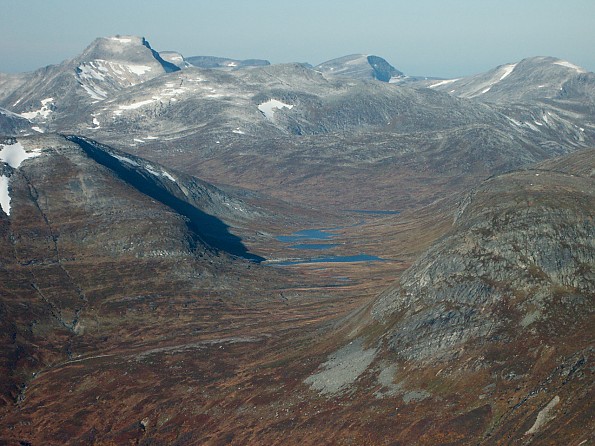
15 years ago, I switched from mountain biking to trail running as my main summer fitness activity. I had various reasons for that, but the main one was that my daughter Molly challenged me to try to do the 60km (36 mile), 2500+ m (8200 ft) Trollheimen Triangle in a single day. The Triangle connects the three main full-service huts in the Trollheimen Mountains, a few hours’ drive from my home in Trondheim, Norway. The trails are mostly rocky, rooty, boggy, and either up or down, only rarely flat and smooth. No amount of mountain biking would prepare my legs for all that rough distance and elevation, especially the downhills. So I started running the trails that used to mountain bike in order to get in shape for the effort. That summer Molly and I finished together in a little over 12 hours, and the next summer I managed to do it in under 11 hours, while Molly surged ahead on the last leg and finished in under 10 hours. (She did it again in 2019 as a mature elite ultrarunner and still holds the FKT: 7:45.)

Back then we just ran with day packs, which can bounce uncomfortably and sometimes chafe, causing raw spots on the back. Now backpack and running gear makers are offering snug-fitting vests in a broad range of volumes to fill that gap. The Duro 6 is Osprey’s mid-size entry, suitable for all-day mountain runs requiring some safety gear, an extra layer or two, water, and enough calories to get to the end of the trail.
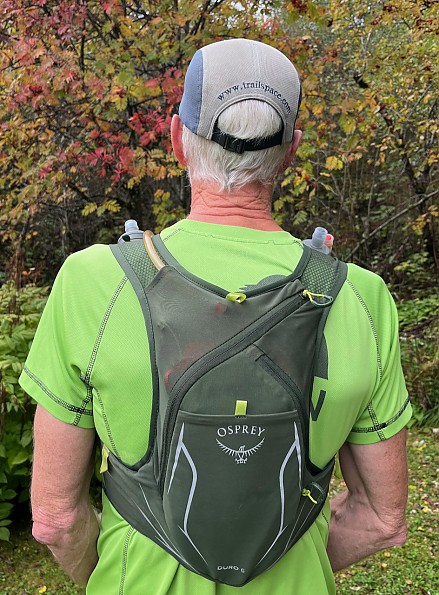
Build and fit

The nominal 6 L capacity of the Duro 6 is approximate. All of the compartments and pockets are made of nylon stretch mesh with enough give to pack in an impressive amount of water, gear and food in such a small package. All outer edges are reinforced with tape and so far I’ve got no rips, tears, or hanging threads. The stretch pockets have pull tabs to help with loading, but I find I don’t use these much on the run as it takes two hands.

The lining against the back and around the waist is a diamond patterned open mesh backed by a lightweight stretch mesh to allow some vapor to escape, but I don’t think any snug-fitting vest can prevent sweat-soaking during strenuous activity. It provides a modicum of padding against the back and waist. The mesh on the front of the shoulder is more open and less padded for more breathability there.
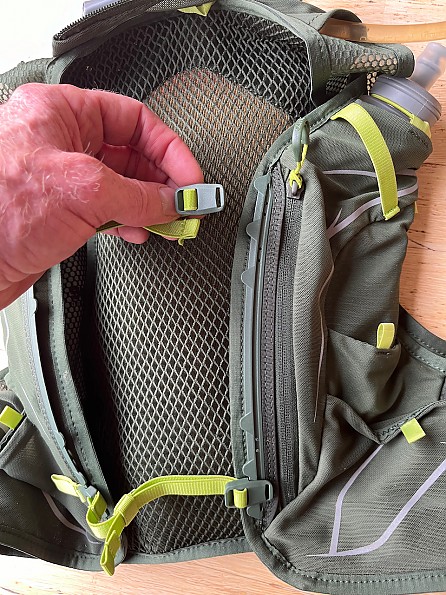
A pair of simple spring clips on adjustable length straps on the right side click onto a bar on the left side of the vest, with two height positions on each strap to customize fit. Finding the clip positions is a bit fiddly at first, but comes with practice and the straps release with a quick lift on the clips. This system is overall lighter, at least as easy to use, and less prone to break as the spring buckles on most packs.

The silk-screened logo accents on the back panel are reflective to help with visibility on dark roads.

My chest measurement put me in a size M which is a good fit, with no bouncing and chafing on the run. The breathable mesh feels good even on a bare back. Without the flasks it weighs in at 284 g (10 oz).
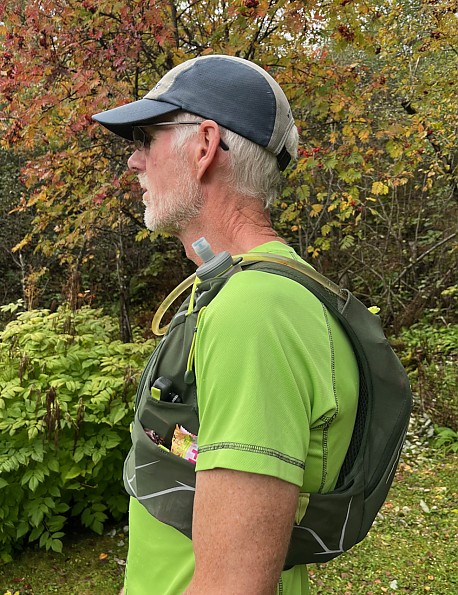
Capacity and loading
The backside of the Duro 6 is all stretch, with two zippered compartments topped off with a kangaroo pouch, and a pair of reachable stretch pockets underneath for extra bars and gels. One side effect of stretch compartments is that they can compete for volume – stuff one full and there may be less space available in its neighbor.
The big zippered compartment will hold a small first aid kit, space blanket, rain gear or maybe an insulating layer, and hat and gloves. The smaller competes for volume with the big one, but can still accommodate, say, a headlamp and sunscreen or maybe a slim lunch pack. The roo pocket will still stretch out to hold more snacks or a wool long top. The two back stretch pockets – more calories!

Up front, the Duro 6 offers a pair of 500 ml soft flasks (included) in stretch pockets at shoulder height, a zippered slash pocket on the left side, and two large and two small stretch pockets for bars, gels, or whatever. The slash pocket can hold a mobile phone and maybe a few other smaller items, but can compete for volume when some of the surrounding pockets are stuffed full. A small emergency whistle will either hang outside or stow inside the top of the slash pocket.

My Garmin InReach fits nicely in one of the small stretch pockets, keeping it from bouncing but with the antenna still exposed for satellite comms. The other stretch pockets will hold as many gels and bars as you can cram into them. The lower, larger stretch pockets will also accommodate a smallish mobile phone in a phone wallet if the zippered pocket gets too crowded.

To see how far the Duro 6 could go, I loaded it up with everything I might want for a late summer go at the Triangle in uncertain weather: mini first aid kit, InReach, cell phone and earbuds, headlamp, space blanket, hat and gloves, rain/wind gear (for keeping warm, not dry, if the weather gets real bad), sunscreen, two full soft flasks, and a couple thousand calories worth of bars, gels, and snacks -- altogether about 2 kg (4.4 lb).
The stretch compartments and pockets took all that in, with room for a few more bars and gels should the need arise. I’ve done some training runs up to about 20 km (12 miles) with that full load. It was light and comfortable enough that I didn’t really think about it much, with none of the bouncing and chafing that can happen with a day pack.
Hydration

The nozzles of the soft flasks are positioned at shoulder height to allow taking a mouthful with a sideways twist of the head. I find that a bit awkward but doable. Stuffing the flasks in the pockets with the vest on and stuffed with other goodies can be a challenge, costing critical time at aid stations in competition but mainly just frustrating for a recreational runner like myself. The tops of the flasks are held in place with elastic loops. These work well enough when the flasks are full, but at about half empty they become looser and can fall down into the pockets so that I have to pull them up and let them hang over the edge of the pocket to keep them accessible. I’d like to see a better way to hold them in place.

For longer or dryer runs, Osprey main zippered compartment on the back will accommodate a reservoir (not included), with a channel to carry the tube over the left shoulder and a simple toggle to hang the top bar of the reservoir. That would hopefully leave some room for a few other essentials. Although Osprey has updated the design of its reservoirs, I’ve found that I can cram my 2017 vintage 2.5 L Osprey Hydraulics reservoir in the big compartment, and I added a magnetic anchor from another Osprey day pack, resulting in very satisfactory arrangement that allows easy access to the tube while keeping it from swinging loose.
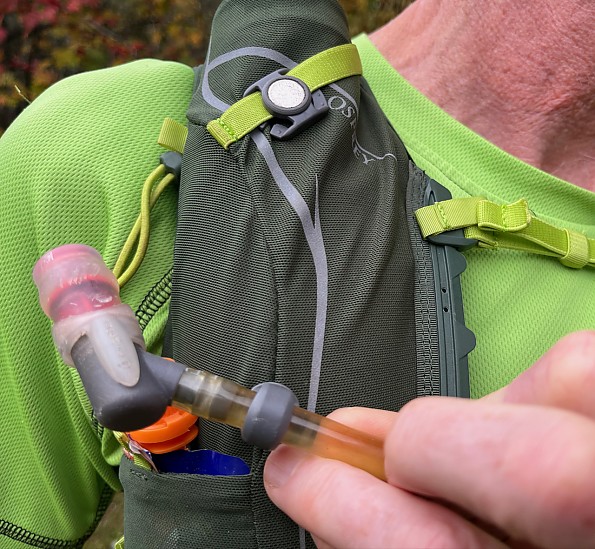
3.5 L total ought to be enough to keep me hydrated on something like the 20 km, bone-dry, over-the-mountain run-hike I did a few years ago in the Catalina mountains north of Tucson on a hot day in early October, when my 2.5 L reservoir ran out with 5 downhill km to go and I ended up badly dehydrated.
Pole (and ice axe?) attachment
Osprey’s product description says that the Duro 6 has trekking pole/ice axe attachment points. The only user’s manual I can find online is for an older model of the pack with attachment loops on top of the shoulder that allow attaching the poles vertically on either the front of back of the back, using the stretch pockets to anchor the lower end. It looks very awkward, especially the front position, where the upper ends end up uncomfortably close to the face.
It took me a while to figure out on my own how (I think) they are supposed to work:

There is a little sliding fitting on the bungee loops on each shoulder that is wide enough to lock onto the cord when it is looped back through itself. With my three-section poles I have to stretch the loops quite a bit to get the poles fastened on. This isn’t especially user friendly – I managed to do the left one on the run, but with my left hand doing the work I eventually came to a full stop to get the right one properly fastened, after it popped open once and the pole fell off. Maybe I’ll get used to it. Having to do each pole separately is also suboptimal. Why not have a way to do the whole bundle in one go—a quiver on the back? Having said that, the poles are out of the way of swinging arms, so it’s functional enough in that sense.
I don’t use trekking poles on most of my training runs, but when I need them for longer and steeper runs I expect I will often end up hand-carrying them between active uses ad rest stops, when I can reattach them properly.
Word
I’ve used the Duro 6 on runs of up to 30 km (18 mi) in conditions ranging from hot summer days, during a visit to the Pacific Northwest this summer, grading into cold and wet autumn conditions here in Norway where I start out with buff and gloves that get stashed in the vest pockets after the first few km. I’ve gone shirtless in the heat, with a t-shirt in intermediate conditions, and with a breathable shell over a wool long top in the cold and wet.
Whether the vest is lightly loaded or packed to the max, it rides comfortably and bounce-free, to the point where I don’t much think about it in between gulps of water and energy bars (and the occasional podcast queue-up). It took a few outings to develop the muscle memory to be able to locate the pockets on the run, but that is now routine. I’m not happy with the trekking pole attachment, however it is supposed to work, but otherwise the Duro 6 is a comfortable and functional companion on longer trail runs where some safety gear and lots of calories are needed.
Now that I’m retired, I’m considering giving the Triangle another go, not so much to try for a better time – I’ve only gotten slower in those 15 years -- but just to see if I still have the juju to do it in day. If I do go, the Duro 6 will be my support team, carrying just enough to keep me safe and caloried up, with minimal pack weight and no bouncing or chafing over all those long kilometers.

The Triangle is calling, and I must go!
Background
I have been trail running for 15 years. I have owned and reviewed one other vest, the 20 L Montane Dragon 20, on Trailspace. I have been using the Duro 6 throughout the 2024 running season, on runs of up to 30 km in the Norwegian mountains, the Pacific Northwest, and in the big forest area near my home in Trondheim, Norway.
Source: bought it new
Price Paid: NOK 1500 including 25% VAT -- about $150
Your Review
Where to Buy
You May Like
Specs
| small | medium | large | ||||
|---|---|---|---|---|---|---|
| Price |
MSRP: $130.00 Current Retail: $129.95-$130.00 Historic Range: $54.93-$130.00 |
|||||
| Volume | 366 cu in / 6 L | - | - | - | - | |
| Dimensions | 5.12 x 16.93 11.61 in | - | 5.12 x 16.93 x 13.58 in | 5.12 x 16.93 x 15.55 | - | |
| Weight | 0.875 lbs | - | 0.924 lbs | 0.972 lbs | - | |

